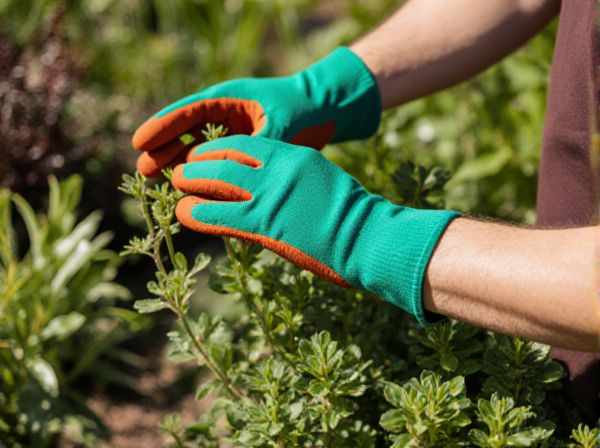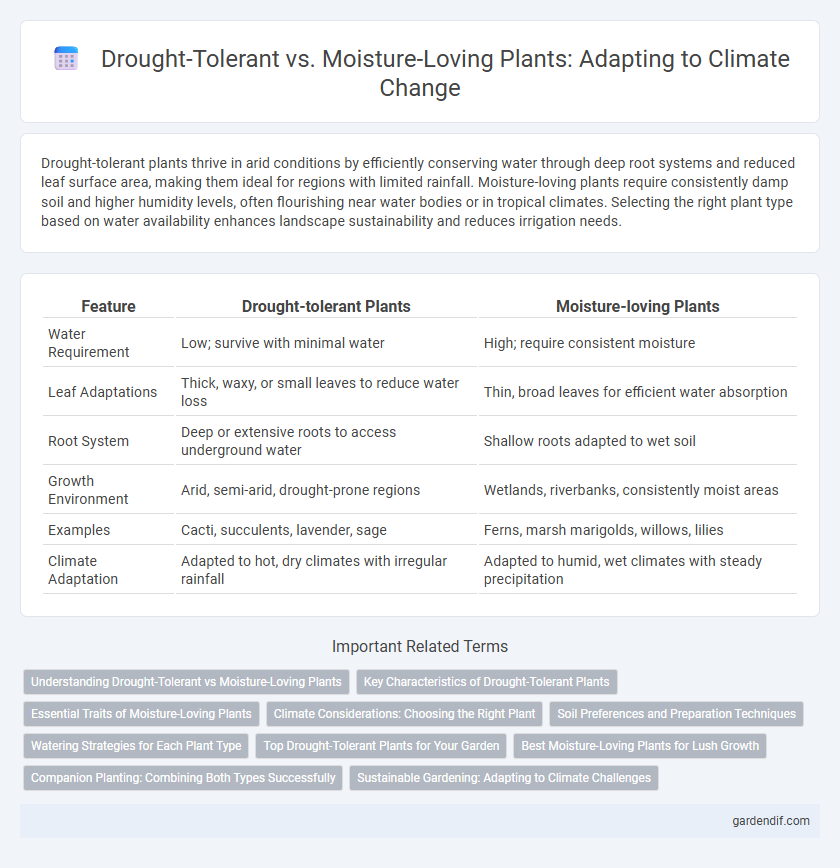
Drought-tolerant plants vs Moisture-loving plants Illustration
Drought-tolerant plants thrive in arid conditions by efficiently conserving water through deep root systems and reduced leaf surface area, making them ideal for regions with limited rainfall. Moisture-loving plants require consistently damp soil and higher humidity levels, often flourishing near water bodies or in tropical climates. Selecting the right plant type based on water availability enhances landscape sustainability and reduces irrigation needs.
Table of Comparison
| Feature | Drought-tolerant Plants | Moisture-loving Plants |
|---|---|---|
| Water Requirement | Low; survive with minimal water | High; require consistent moisture |
| Leaf Adaptations | Thick, waxy, or small leaves to reduce water loss | Thin, broad leaves for efficient water absorption |
| Root System | Deep or extensive roots to access underground water | Shallow roots adapted to wet soil |
| Growth Environment | Arid, semi-arid, drought-prone regions | Wetlands, riverbanks, consistently moist areas |
| Examples | Cacti, succulents, lavender, sage | Ferns, marsh marigolds, willows, lilies |
| Climate Adaptation | Adapted to hot, dry climates with irregular rainfall | Adapted to humid, wet climates with steady precipitation |
Understanding Drought-Tolerant vs Moisture-Loving Plants
Drought-tolerant plants, such as succulents and cacti, possess specialized adaptations like deep root systems and water-storing tissues that enable survival in arid climates with minimal water. Moisture-loving plants, including ferns and water lilies, thrive in consistently damp environments due to their shallow roots and high transpiration rates. Understanding these differences is crucial for selecting appropriate vegetation based on soil moisture availability and regional climate conditions.
Key Characteristics of Drought-Tolerant Plants
Drought-tolerant plants exhibit deep root systems, reduced leaf surface area, and waxy or hairy leaf coatings that minimize water loss and enhance survival in arid conditions. These plants often feature succulent tissues for water storage and employ CAM photosynthesis to optimize water use efficiency during periods of limited moisture. Their ability to withstand prolonged dry spells makes them essential for xeriscaping and landscaping in drought-prone regions.
Essential Traits of Moisture-Loving Plants
Moisture-loving plants possess essential traits such as extensive root systems that efficiently absorb and retain water in saturated soils, enabling survival in consistently wet environments. Their leaves often feature a thin cuticle and abundant stomata to facilitate gas exchange without excessive water loss. Adaptations like aerenchyma tissue promote oxygen transport in waterlogged conditions, ensuring metabolic functions continue despite drought intolerance.
Climate Considerations: Choosing the Right Plant
Drought-tolerant plants, such as succulents and native grasses, thrive in arid and semi-arid climates by conserving water and withstanding prolonged dry periods. Moisture-loving plants, including ferns and tropical species, require consistently high humidity and ample water supply, making them suitable for humid, wet climates or areas with frequent rainfall. Selecting the appropriate plant based on regional climate patterns maximizes growth efficiency and resource management while reducing maintenance needs and environmental stress.
Soil Preferences and Preparation Techniques
Drought-tolerant plants thrive in well-drained, sandy, or rocky soils with low organic matter, requiring minimal irrigation and benefiting from mulching to preserve soil moisture. In contrast, moisture-loving plants prefer rich, loamy soils with high organic content that retain consistent moisture levels, necessitating regular watering and soil amendments like compost to enhance water retention. Proper soil preparation for drought-resistant species emphasizes improving drainage and reducing water retention, while moisture-loving plants need soil conditioning to maintain optimal hydration and nutrient availability.
Watering Strategies for Each Plant Type
Drought-tolerant plants require deep, infrequent watering to encourage extensive root growth, enhancing their resilience in arid conditions. Moisture-loving plants thrive with consistent, shallow watering to maintain evenly moist soil, preventing stress and supporting rapid growth. Tailoring irrigation methods to these needs optimizes water efficiency and plant health in varying climates.
Top Drought-Tolerant Plants for Your Garden
Top drought-tolerant plants for your garden include succulents like agave, sedum, and aloe vera, which require minimal water and thrive in arid conditions. Native grasses such as buffalo grass and blue grama are efficient in conserving water while maintaining resilience during prolonged dry periods. Lavender and Russian sage also offer fragrant, low-maintenance options that flourish with limited moisture, making them ideal for sustainable gardening in drought-prone regions.
Best Moisture-Loving Plants for Lush Growth
Moisture-loving plants such as ferns, ginger, and marsh marigolds thrive in consistently wet environments, making them ideal for creating lush, vibrant gardens in humid or water-rich landscapes. These plants excel at absorbing and retaining moisture, promoting dense foliage and vigorous growth even in low-light conditions. Selecting moisture-loving species enhances garden biodiversity and supports local ecosystems by providing habitat for moisture-dependent wildlife.
Companion Planting: Combining Both Types Successfully
Companion planting combines drought-tolerant plants like succulents and lavender with moisture-loving plants such as ferns and hostas to create resilient garden ecosystems that optimize water use. Strategically placing drought-tolerant plants in sun-exposed areas reduces competition for water with moisture-loving companions thriving in shaded, cooler spots. This method enhances soil moisture retention, improves plant health, and supports biodiversity by balancing the distinct water needs of each plant type.
Sustainable Gardening: Adapting to Climate Challenges
Drought-tolerant plants, such as succulents and native grasses, require minimal water and thrive in arid conditions, making them ideal for sustainable gardening in regions facing prolonged dry spells and water scarcity. Moisture-loving plants, like ferns and water lilies, demand consistent hydration and are suited for garden areas with abundant natural rainfall or reliable irrigation, supporting biodiversity in wetter climates. Selecting appropriate plant types based on local climate resilience and water availability reduces environmental impact and conserves precious resources in sustainable garden design.
Drought-tolerant plants vs Moisture-loving plants Infographic

 gardendif.com
gardendif.com